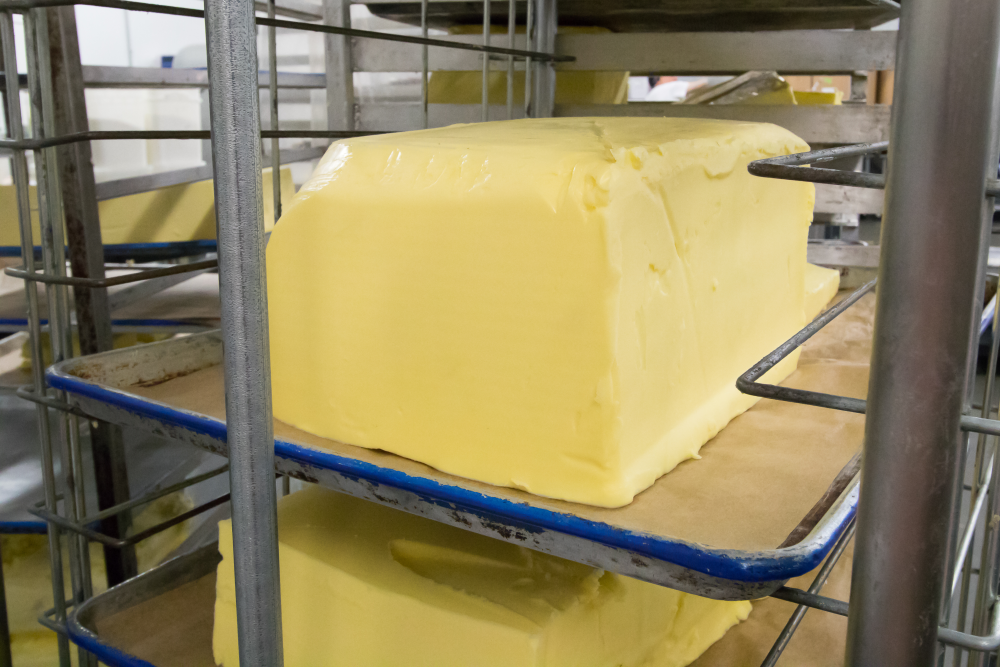You’ve probably heard that baking is a science. Or perhaps you’ve heard that it’s an art. In our opinion, it’s a bit of both. The process of developing a recipe (what we in the industry call research and development, or R & D) is long and involved. It often takes countless iterations to get it just right—“it” being the flavor, the texture, and the overall experience for whoever’s enjoying the fruits of our labor.
For this to happen, the ingredients must complement each other not just in flavor, but also in how they interact with each other. The exact combination of ingredients in a baking recipe is really important—change one thing, and you could end up with something very different. You can see this in action by reading the comments section of any baking blog. Users often complain that a recipe didn’t turn out, but then go on to mention all the modifications they made (much to the annoyance of whoever developed the recipe in the first place).
What may seem like a simple swap can make a bigger difference than you might think—for better or for worse! This is the first article in a multiple-part series where we’ll discuss common ingredient substitutions in recipes and how that could impact your end product. Up this week: the fats!
The Fats: Butter, shortening, and oil (and applesauce!)
Most cookie, cake, and pastry recipes have some kind of fat in them, often butter, shortening, or oil. Below, we’ll go into detail about the differences between these types of fat, and at the end of this article, we’ve created a quick reference guide.
Butter
Butter is almost entirely made up of fat, but it has some other key components, too. Around 80% of butter is fat, 16% is water, and the other 4% is salt (if present) and milk solids. Aside from the rich flavor butter adds to baked goods, it also impacts texture. As your cookies or pies bake, the water in butter turns into steam, which interacts with the flour and adds to the texture and “crumb” of the product. This gives you those lovely crisp-cookie and flaky-pastry textures!
We’re big fans of butter at Little Rae’s, but it also has its downsides. It is the most expensive of the fats, which can add up if you’re doing a lot of baking. Baked goods made with butter also tend not to last as long as those made with oil—the water content in butter causes it to dry out faster. Lastly, though butter does have that magnificent taste, it does contain the “bad fats,” which should be consumed only in moderation.
Shortening and Lard
Shortening, on the other hand, is 100% fat. Shortening is also shelf-stable, is manufactured to be solid at room temperature, has a higher melting point than butter. If you need to bake vegan, vegetable shortening has you covered there. Since shortening doesn’t contain water, that steaming effect doesn’t happen, which can be great if you’re looking for cookies that are taller, fluffier, and more cake-like. But you won’t get that crunchy or flaky outer crust with shortening, and you might miss the rich flavor of butter since shortening is generally tasteless.
You may also come across recipes calling for lard, which is a type of shortening made from animal fat (usually pork). Like its vegetable-based counterparts, lard doesn’t have a distinct flavor. However, it does contain fewer of the bad fats than butter does, and it tends to be less expensive as well. These days, lard tends to mostly be used in pie crust recipes—there’s actually an ongoing argument in the baking community about whether lard or butter makes the best pie crust. Our advice: try both out and see what you think!
Oil
Oil is also 100% vegetable fat, but obviously it’s in liquid form. We wouldn’t advise swapping in oil for cookies or pie crusts, but it turns out it works well for cakes, quick breads, crusty breads, and pizza crusts. The lighter weight of oil can help create lighter, fluffier cakes and breads.
Oil is a fairly broad category in itself, as there are many different types of vegetable fats that could be used in baking. Other than the basic vegetable oil, you might consider trying out corn, canola, or olive oil. Each will affect your baking differently in flavor and texture, and you might find that one suits a particular recipe best. For example, olive oil works really well in breads, pizza doughs, and crackers but isn’t usually as good for pastries due to its strong, distinct flavor. On the other hand, canola and corn oil are great options for cake-like goodies.
Like the other fats in this blog, oil is often less expensive than butter—though this can vary a lot depending on the quality and type of oil. In addition, it can extend the shelf-life of a product since there is not any water to dry out (that’s one of the reasons you see a lot of oils and hydrogenated oils in the baking industry). One other interesting note is that cake-like products made with oil can be ready to serve straight out of the fridge, whereas cake-like products made with butter often require some time to come up to room temperature (due to butter solidifying when cold).
Margarine
Margarine is an interesting in-between. Like butter, it contains some water and has a flavor (meant to mimic butter). It can be used as a 1:1 substitute for butter and some other oils in baked goods. Like shortening, it costs less than butter. However, it also contains hydrogenated oil (which contains trans fat), which may be a concern for some.
One interesting benefit to margarine is that because it is easily spreadable and scoopable, it can be much easier to work up into frosting, cream into sugar, or otherwise use where softened butter is called for. Margarine is made from vegetable oils but may contain milk, so it’s vegetarian but not necessarily vegan (be sure to check the label).
Applesauce
Applesauce is not a fat, but it is a common recommendation for oil and fat substitution in recipes. While this can work, be prepared for noticeable changes to texture and taste. Typically, applesauce will make the texture more cake-like and the flavor sweeter. It works best in quick breads and muffins. It can be a great option if you are looking to reduce fat, avoid animal products, or just experiment for fun. We’d recommend trying this out in moderation to begin—perhaps replacing only half the oil/fat in a recipe and seeing how it goes before making further adjustments. Don’t be discouraged if it flops the first time; it might take multiple tries to get the ratios just right.
Quick Reference Guide: Fat & Oil Options for Baking
Wow—that was a lot of information! As you can tell, there are a lot of options out there, and each one is unique. It can make substituting ingredients perilous at times, but we like to think of it all as good, clean fun! For your quick reference, here are a few key bullet points from each type of fat we discussed:
Butter
- Tastiest; can be spread on toast and enjoyed
- Provides the most dynamic texture in baked goods
- Dries out the fastest due to water content (shorter shelf life)
- Contains lots of calories and saturated fat (the “bad” fat)
- Expensive
Shortening
- 100% fat (no water content)
- Vegetable shortening is vegan and shelf-stable
- Manufactured to be solid at room temperature
- No discernible flavor
- Does not dry out, giving baked goods a longer shelf life
- Produces items that are spongy but lack dynamic textures (ex: crunchy outside, moist in the middle)
Lard
- 100% fat (no water content)
- Made from animal fat
- No distinct flavor
- Fewer bad fats than butter
- Less expensive than butter
- Most often used in pie crusts
Oil
- 100% fat (no water content)
- Each type will affect your baking differently
- Vegan/vegetarian
- Extends shelf life of products and items can be served right out of the fridge
- Canola & Corn
- Often used for cake-like products
- Less expensive than butter
- Olive
- Often used for products like pizza crusts, breads, and crackers
- Stronger flavor makes it less desirable for pastries
- Cost varies
Margarine
- Contains some water
- Flavor mimics butter
- Can be used as a 1:1 substitute for butter or other fats
- Contains hydrogenated oil
- Less expensive than butter
Applesauce
- Reduces fat in recipes
- Vegan/Vegetarian
- Adds sugar and flavor
- Changes texture of product
- Might take a few attempts if substituting for fat/oil in a traditional recipe
At Little Rae’s, we prefer to use butter in our products because of its overall superior taste, texture, and consistency—but we do use oils as well. That isn’t to say that these other kinds of fat (or applesauce!) don’t have a place in your home kitchen. We’re always proponents of playing in the kitchen, having fun, and most importantly, finding out what works best for you!
If you’re considering swapping out one kind of fat for another in a recipe, keep in mind why you’re making the change, how it will impact your final product, and whether that’s what you’re looking for or not. For fat reduction, vegan or vegetarian needs, or a different desired end product result, switching up the type of fat used might just be what you need.
That’s all for this time—join us again next month when we’ll be moving on to Part 2 of this article series—flours! We’ll talk about some of the most common flour substitutes, whether they work as 1:1 swaps, and how they’ll impact the texture and flavor of your bake. See you then!

